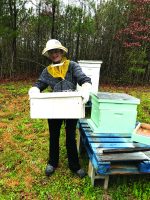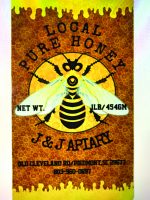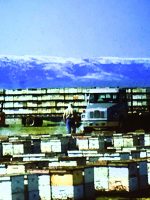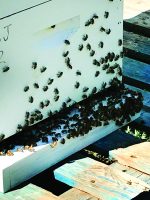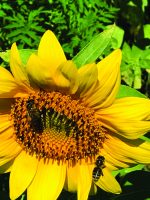Out of 25,000 species of bees, only one, that produces honey, has been domesticated to the point of being legally classified as live stock. We offer housing and food (if they choose to accept) and they offer us honey, wax and pollination (all of which, we gladly accept). The Apis Mellifera (translated as Bee Honey), not being native to America, was brought to America by the early explorers. They knew they would need (wax) candles to light the night. Still today one of the top users of honey bee wax are the candle makers.
Honey bees are far from individual bees; in fact, they are eusocial. An average hive (the honey bees home) contains one queen, twenty five hundred male bees and fifty thousand female bees. Eusocial means that not one of these three caste can live without the help of the other two. A truly perfectly functioning society.
The honey bee has one, and only one, purpose in life: to survive the next winter! One thing that makes this truly remarkable is that the average life of a honey bee is from five to eight weeks. Most of the bees (lets just call the honey bee “bee” from the rest of this article) will not live to see the winter! Somehow they all know it takes two things for their family to survive the coming winter: food and many bees.
The queen has one function in the family: birth baby bees. The queen is created by the females (usually referred to as the girls). It takes about sixteen days for the girls to raise a new queen. She leaves the hive once in her life time (which is from three to five years) to mate with multiple males. She returns home and begins laying eggs at the rate of an average of 1,500 per day! Over eight hundred thousand in her life time.
The males in the hive also have one purpose in the family: to mate with the queen. It takes about twenty four days to produce a male.The males go out each day and congregate high in the air with other males hoping for their big chance. What they may not know is that if they get lucky, the queen rips the reproduction organs from his body and sends him to his death. Are the ones that don’t get their chance the lucky ones: hardly! They return to the hive and are feed and allowed to sleep inside until winter approaches and food needs to be conserved, at which time the girls boot them out of the front door to starve or freeze to death (which ever comes first).
This leaves the girls. They have multiple purposes in the family. It takes about twenty one days to produce a female. As you probably gathered, the females do all the work. Household chores are assigned by age; newly hatched girls are nurse bees; others produce wax with which the builders construct the comb, others take care of the queen (including feeding her and disposing of her waste); others clean up the hive (including hauling out the bees that die daily); the majority of the girls become foragers, making ten to fifteen trips daily of six to ten miles round trip, to gather pollen (for protein), nectar (for carbs), sap (for making propolis..a cementing glue) and water ( for nourishment and for cooling the hive). The foragers bring these supplies back to the hive front door and pass them off to awaiting workers. In the case of nectar, the bees pass it from mouth to mouth adding nutrients and taking out moisture. Once the moisture is low enough they deposit this nectar into a cell and begin fanning it until the moisture is below 18%; it is then capped over as perfect honey. As for the pollen, the girls mix small balls of the pollen with protein, minerals, vitamins and fatty acids, sealed with saliva and a drop of honey; this mixture is call bee bread and is the main food source for the hive. The girls are in charge of notifying the foragers as to what to bring home and telling the queen which sex the hive needs a next (usually more girls!).
An average hive produces around one hundred pounds of honey per year. The foragers must visit approximately two million flowers to produce one pound of honey. At 12 miler per hour they must travel about 55,000 miles for this one pound of honey; that’s equivalent to flying twice around the world. One girl working as hard as she can produces about 1/12 of a teaspoon of honey in her life! At 11,400 wing strokes per minute, she literally flies her wings off, for the family, to her death. Getting where the term “busy as a bee” comes from?
The honey bees are cold blooded which means the temperature inside the hive must be maintained from from 93-95 degrees Fahrenheit. The girls accomplish this temperature control by fanning their wings inside the hive to bring the temperature down or standing at the door fanning air into the hive to warm it up.
Now we’ve said their only purpose in living is to survive the next winter. We’ve seen they are busy making honey but how do they make more bees…cheering on the queen to lay more and more…not hardly; at 1500 eggs per day she’s doing about all she can do…so what next; winter is coming! The queen assesses strength of the hive; if more bees are needed for the winter the queen packs her bags and leads nearly 60% of the hive to start another hive. This is called “swarming”. The remaining 40% quickly make themselves another queen and begin raising the population of the hive back up to full strength. The bees make themselves a new queen by building several extra large cells (known as a queen cells). It looks something like a peanut. Fertilized eggs are placed in each of the large cells and the bees in charge of feeding everyone begins feeding this queen cells royal jelly. The nurse bees secrete royal jelly from a special gland called the hypopharynx. All bee larva are given a small amount of royal jelly but the larva in the queen cell is feed only royal jelly. In 16 days the first queen will emerge. Since each hive can only have one queen, her first job is to rip open the other queen cells and destroy her competition. We now have two hives instead of one…twice as many bees.
Now we’ve talked about the hive and the honey but the most important mission the bee accomplishes, quite by accident, is while gathering nectar, the bees pollinate the flowers and crop. Pollinators pollinate one third of all our food and three fourths of all crops. Many many insects help pollinate flowers and crops but the honey bee does 80% of the job. With the constant increase in population(taking up more and more land), global warming, the wide spread use of fertilizers and sprays, the use of many insecticides and the invasion of the varroa destructor mite the honey bee population has decreased by 45%. Thousands of hives must be moved around America to pollinate crops; then moved to another crop location, and on and on. There are over 200,000 bee keepers in America.
My hope is by sharing facts about the life of the honey bee you’ll find it so intriguing that you will want to become a bee keeper or at least consider the honey bees when planting flowers and using pesticide and insecticides..
I am one of those 200,000 bee keepers. My grandson and I run the J&J Apiary located in the mist of a large Piedmont forest. We are small but hoping to grow. Our Piedmont forest honey is delicious and, as all pure local honey, very healthy. Having trouble with allergies or frequent colds, try a teaspoon of honey a day! Our 12ounce bears or oval containers are $8 each or two for $15. The small 2ounce bear is $3 or two for $5. Contact info is jimmccormac@yahoo.com or 803-960-0697.♦

